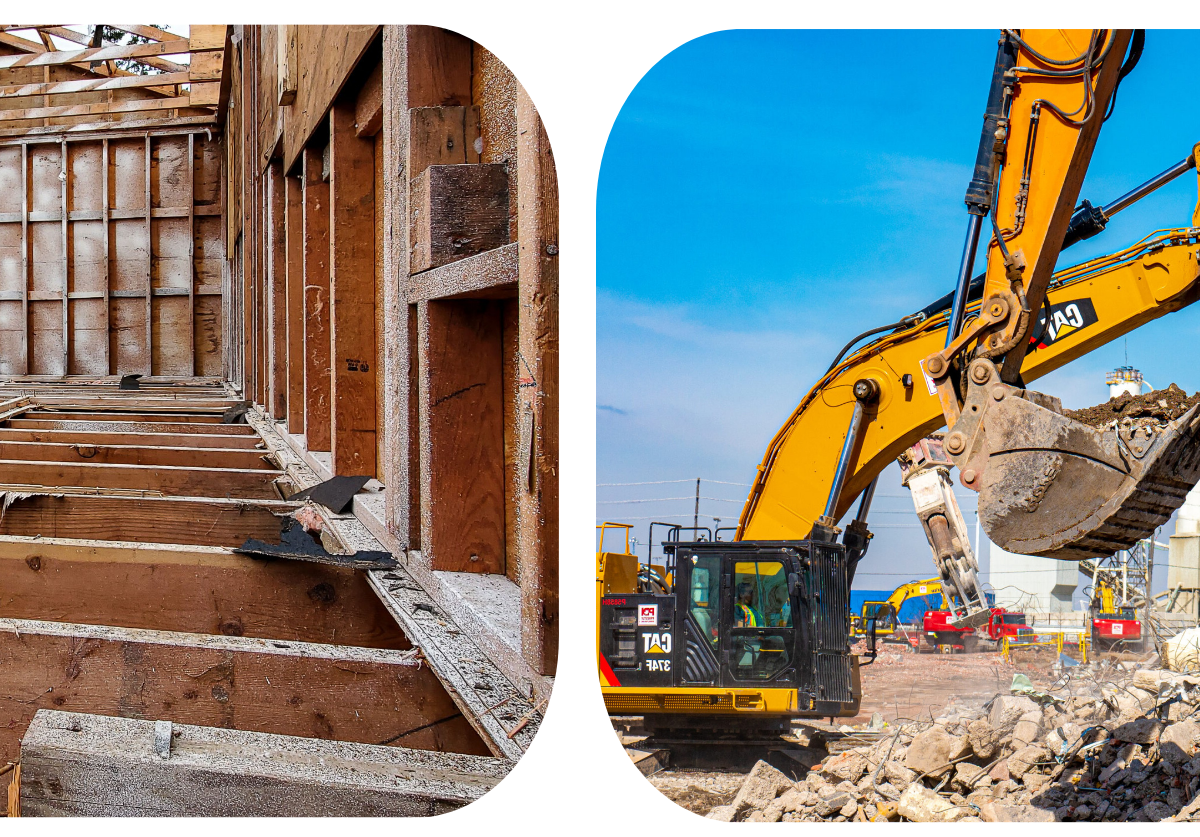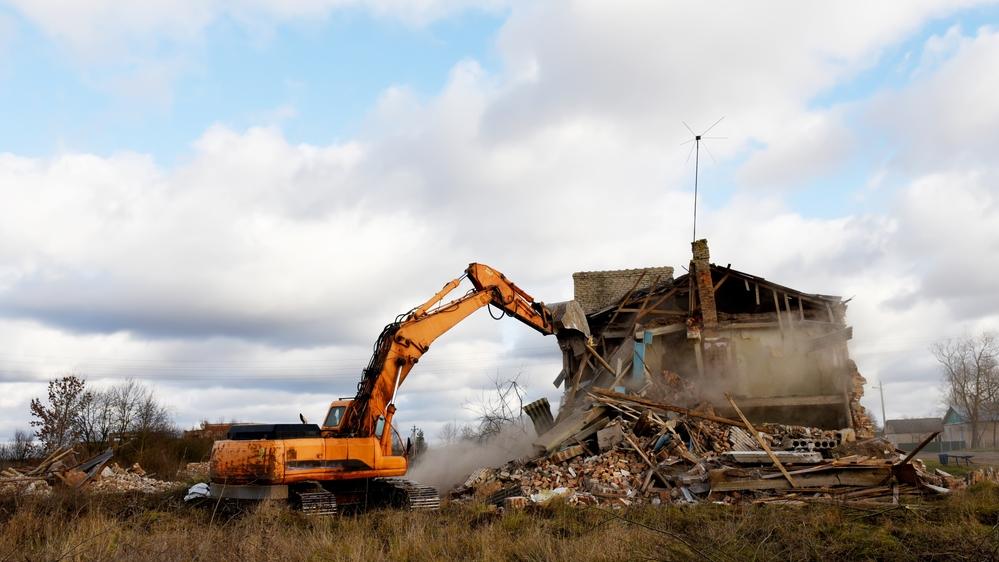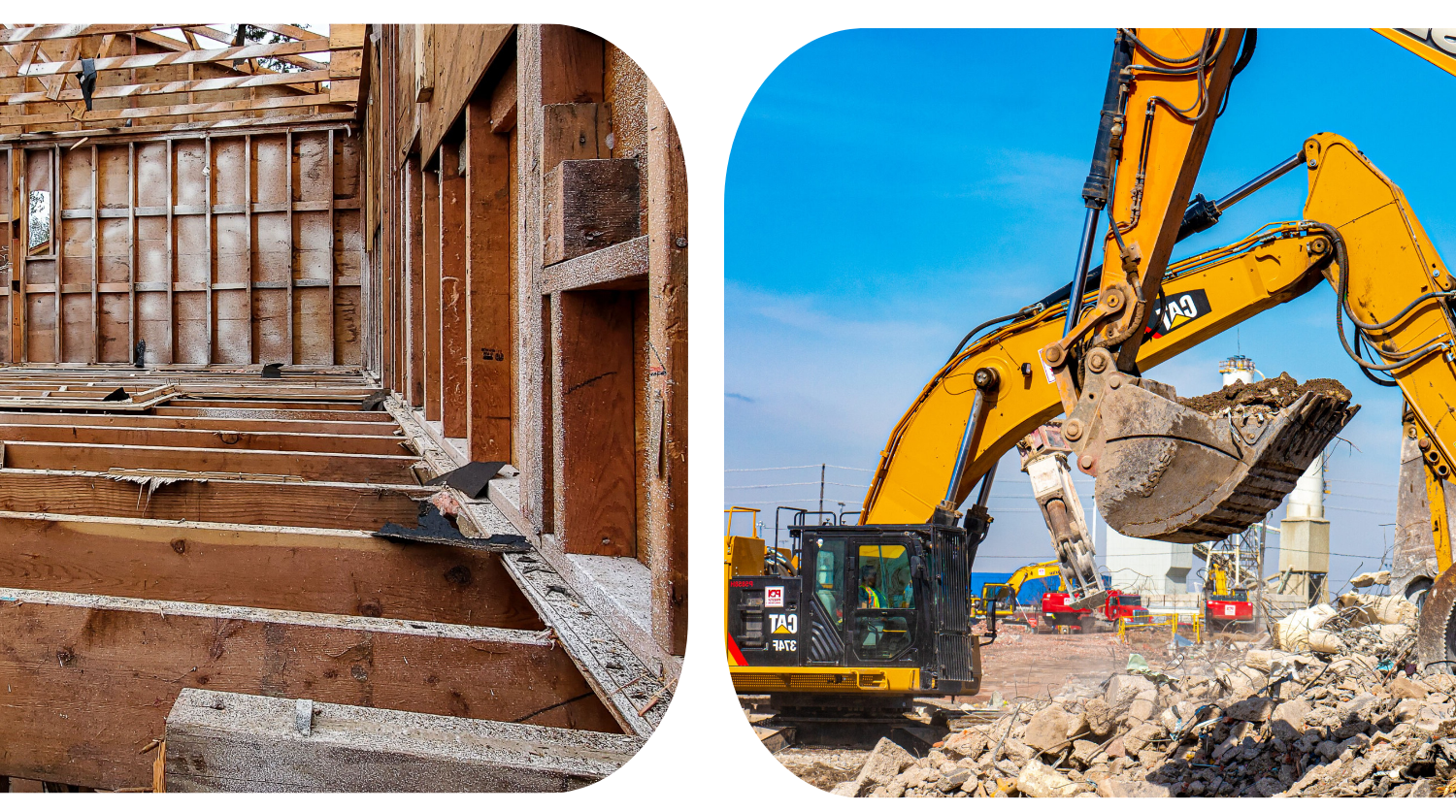Introduction: Navigating the Crossroads of Deconstruction vs. Demolition
In the face of escalating environmental concerns, the construction and demolition industry stands at a crossroads. Traditional practices, once the backbone of building and redevelopment projects, are being scrutinized for their Deconstruction vs. Demolition footprint. The advent of sustainability as a crucial industry pillar has introduced a pivotal dialogue: Deconstruction vs. Demolition. This discussion not only addresses the methods of dismantling structures but also underscores a broader commitment to environmental conservation. Understanding these concepts is essential for anyone involved in building, from developers to homeowners, as they navigate the path toward more sustainable practices.
Deconstruction vs. Demolition: Understanding Traditional Demolition
Definition and Process
Traditional demolition is a method that involves the tearing down of buildings and structures, typically using heavy machinery such as bulldozers, excavators, and wrecking balls. This process is commonly employed to clear old, unsafe, or otherwise unwanted buildings to make way for new construction. It is characterized by its speed and efficiency, allowing for rapid clearing and redevelopment of sites.
Environmental Impact
While effective for its intended purpose, traditional demolition has significant environmental drawbacks. The process generates substantial amounts of waste, much of which ends up in landfills. This not only contributes to the growing problem of waste management but also results in the loss of valuable materials that could otherwise be reused or recycled. Additionally, demolition activities release dust, pollutants, and greenhouse gases, contributing to air pollution and climate change. The environmental impact of demolition is becoming increasingly untenable in the context of global efforts to reduce carbon footprints and promote sustainability.
For more information on demolition services, visit BC Green Demolition Company Vancouver
Exploring Deconstruction: A Sustainable Alternative
Definition and Process
Deconstruction presents an eco-friendly alternative to traditional demolition. This method involves carefully dismantling buildings piece by piece, with the goal of preserving as much of the material as possible for reuse and recycling. Unlike demolition, deconstruction is a more labor-intensive process that requires detailed planning and execution. However, it offers a way to minimize waste and extend the lifecycle of building materials.
Benefits of Deconstruction
The Deconstruction vs. Demolition debate showcases the multifaceted benefits of deconstruction, including environmental, economic, and social advantages. Environmental benefits include significant waste reduction and the conservation of resources, which align with global sustainability goals. Economically, deconstruction can offer long-term savings through the sale of salvaged materials and potential tax incentives. Socially, deconstruction supports the green job sector and community development through the donation of materials to non-profits, highlighting the comprehensive benefits of choosing deconstruction in the Deconstruction vs. Demolition discourse.
On other words, the benefits of deconstruction are manifold, encompassing environmental, economic, and social aspects:
- Environmental Benefits: Deconstruction significantly reduces the amount of waste sent to landfills by salvaging materials that can be reused or recycled. This not only conserves natural resources but also reduces the environmental impact associated with the production of new building materials. Furthermore, by minimizing emissions from waste processing, deconstruction contributes to cleaner air and a healthier environment.
- Economic Benefits: Although deconstruction can be more labor-intensive and potentially more costly upfront than traditional demolition, it offers economic advantages in the long term. Salvaged materials can be sold, providing a return on investment. Additionally, some jurisdictions offer tax incentives or credits for sustainable building practices, including deconstruction.
- Social Benefits: Deconstruction creates more job opportunities than demolition, as it requires a skilled workforce to carefully dismantle structures. This not only contributes to local economies but also supports the growing sector of green jobs. Furthermore, salvaged materials can be donated to non-profit organizations, supporting community development projects and making building materials more affordable.
Comparative Analysis: Deconstruction vs. Demolition
When deciding between deconstruction and demolition, several factors come into play, including cost, time, environmental impact, and regulatory considerations. Each method offers distinct advantages and challenges, making it essential to evaluate them comprehensively.
Cost Comparison
At first glance, traditional demolition appears more cost-effective than deconstruction. Demolition requires less labor and time, leading to lower initial costs. However, this perspective does not account for the long-term financial and environmental benefits of deconstruction. Deconstruction enables the salvage and resale of materials, which can offset the higher upfront costs. Additionally, certain jurisdictions offer financial incentives for sustainable practices, including tax deductions or credits for salvaged materials, further reducing the net cost of deconstruction.
The environmental cost savings are also significant. By reducing landfill waste and conserving natural resources, deconstruction diminishes the ecological footprint of construction projects. While these savings may not be immediately quantifiable in monetary terms, they contribute to broader societal benefits, including reduced environmental remediation costs and conservation of resources for future generations.
Time and Efficiency
Demolition is generally faster than deconstruction, making it the preferred choice for projects on tight schedules. The efficiency of demolition allows for rapid site clearing and redevelopment, which can be crucial for time-sensitive construction projects.
Deconstruction, while more time-consuming, offers a different kind of efficiency. The careful dismantling process ensures that materials are preserved in a condition suitable for reuse, contributing to a circular economy. For projects where time is not the primary constraint, deconstruction presents an opportunity to maximize resource recovery and minimize waste.
Environmental Impact
The environmental impact of deconstruction versus demolition is starkly different. Demolition generates significant amounts of waste, much of which is non-recyclable and ends up in landfills. This contributes to the depletion of landfill space and the environmental damage associated with waste management. Moreover, demolition practices can release harmful substances into the environment, including dust and asbestos, posing health risks to workers and surrounding communities.
Deconstruction vs. Demolition: Shaping the Future of Sustainable Building
The construction and demolition industry is undergoing a significant transformation, driven by the global imperative to mitigate environmental impact and adapt to changing societal expectations. This shift towards sustainability is not merely a trend but a fundamental change in how buildings are conceived, constructed, and deconstructed. As we look to the future, several key factors are shaping the landscape of sustainable building practices.
Technological Advancements
Innovation in technology plays a pivotal role in enabling more sustainable construction and demolition practices. Cutting-edge tools and techniques are making it possible to build with greater efficiency, reduce waste, and improve the recyclability of materials. For instance, digital modeling and simulation tools allow architects and engineers to optimize designs for energy efficiency and material conservation before construction begins. Robotics and automated deconstruction technologies are emerging, offering the potential to dismantle structures more precisely, thereby maximizing the salvage of materials and reducing the need for manual labor.
Moreover, new materials are being developed with sustainability in mind. From bio-based materials to those designed for easier recycling, these innovations are reducing the environmental footprint of buildings. Smart materials, which can adapt to environmental conditions to optimize energy use, are also contributing to more sustainable buildings.
Policy Changes
Governments around the world are recognizing the need for policy frameworks that support sustainable building practices. Legislation aimed at reducing waste, encouraging the reuse and recycling of building materials, and mandating energy efficiency is becoming more common. These policies not only set standards but also incentivize stakeholders to adopt greener practices through tax benefits, grants, and subsidies.
The Future of Green Building: Simplified Insights
New Tools and Innovations in Construction
In the future, building homes and offices will be a lot like playing a video game. Architects will use software that’s a bit like Minecraft to design buildings that don’t waste any space or materials. Imagine robots that can carefully take apart old buildings so we can reuse almost everything, from bricks to beams. Also, scientists are coming up with new materials, like wood that doesn’t burn or concrete that eats up pollution, making our buildings smarter and safer for the environment.
Changes in Building Rules
Governments are stepping up to make sure new buildings do their part for the Earth. They’re creating laws that say buildings need to use less water and power and recycle more. These laws help by giving builders a pat on the back, like tax breaks or faster approvals, if they build in ways that are good for the planet. This means more green spaces in cities, buildings that cost less to heat or cool, and healthier places for us to live and work.
Earning Green Badges
Buildings can earn special badges, kind of like scout badges, for being extra kind to the environment. These badges, from programs like LEED or Energy Star, tell everyone that a building is designed to save energy and water and reduce pollution. Having one of these badges is becoming a big deal because it shows a building is not only good for the planet but can also save money over time. More people now want these badges for their buildings, making them more popular and valuable.
Looking Ahead: A Greener Tomorrow
The next chapter in building is all about making friends with nature. Soon, buildings won’t just be places to live or work; they’ll help power themselves with renewable energy like sunlight or wind, and they’ll clean the air and water around them. The goal is to have cities full of green roofs, solar panels, and walls that breathe, creating cleaner, healthier places for everyone. We’re working towards a future where every new building adds to the health of our planet, making it a better place for us and future generations.
As the construction industry grapples with environmental concerns, the debate between deconstruction and traditional demolition takes center stage. The U.S. Environmental Protection Agency (EPA) and the National Waste & Recycling Association (NWRA) both highlight the significant environmental benefits of deconstruction, including reduced landfill waste and resource conservation.





